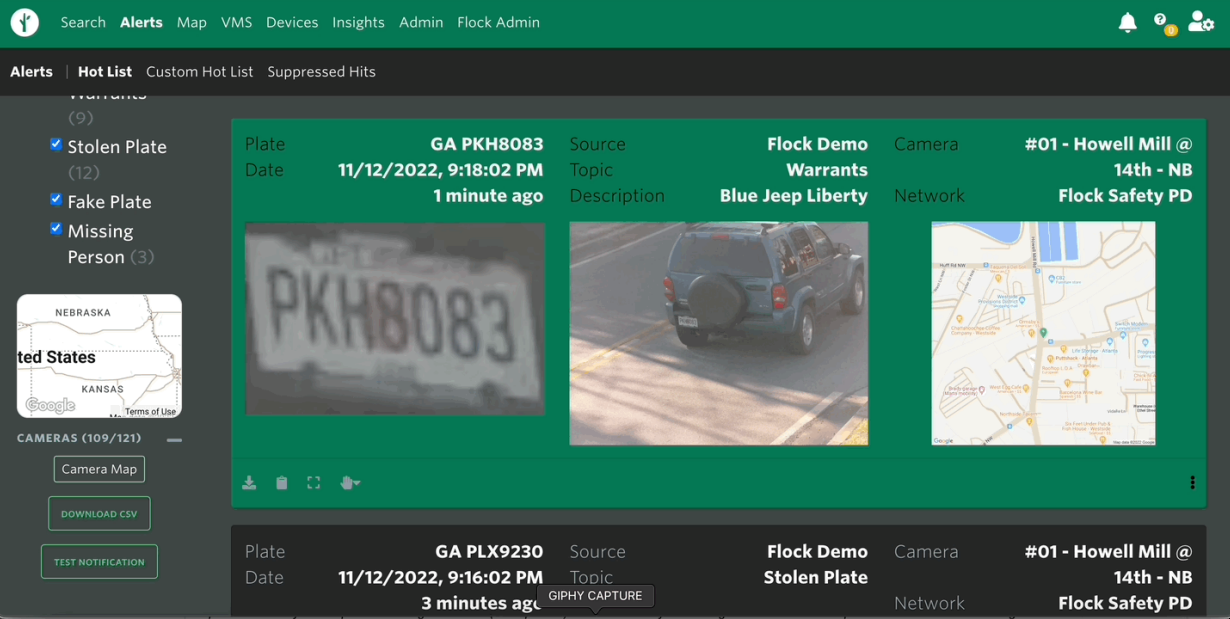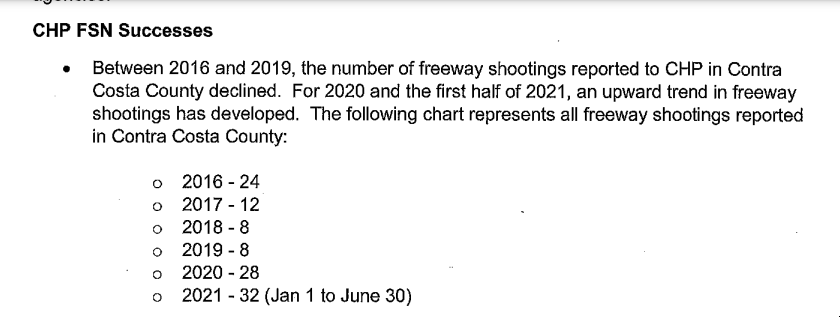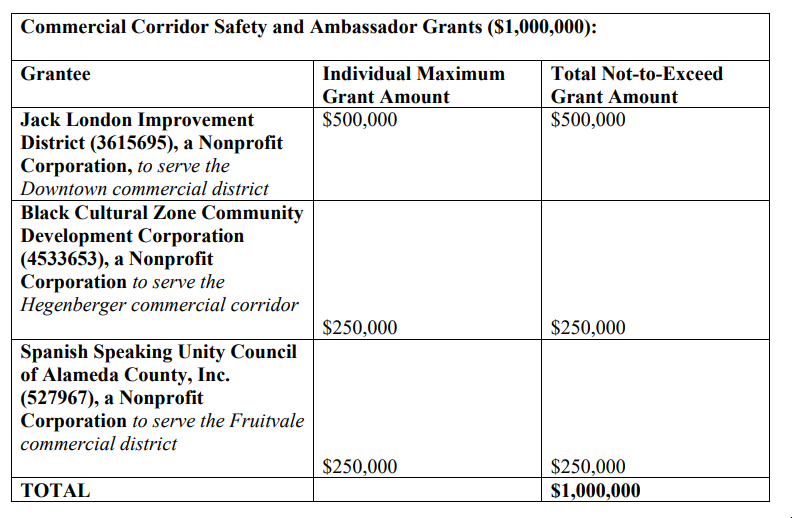PAC Approves OPD ALPR Use Policy
In a brief meeting that lasted under an hour, the Oakland Privacy Advisory Commission [PAC] approved OPD’s use policy for a new Flock Automated License Plate Reader [ALPR] system last Thursday. As substitute Chair Henry Gage* and other Commissioners noted, the speed of the deliberation and unanimity among Commissioners in passing the policy as presented likely had to do with the input of several Commissioners in an ad hoc** committee with OPD over the past several months that ultimately produced the final version of the use policy. The PAC will forward a recommendation to Council to adopt the use policy, a necessary step under law to fund and authorize the system.
The new policy for the Flock system differs from OPD’s previous use policy for vehicle-mounted ALPR cams, amended on the dais by former D4 Council member Sheng Thao last October and unanimously celebrated by CMs and OPD Chief Leronne Armstrong alike at passage. The October use policy had 6 month data retention and a quarterly audit requirement—the latter was applauded by Armstrong during the meeting, but months later, as reported by the Oakland Observer, OPD stated that very requirement was too arduous to fulfill and suspended its use of the vehicle-mounted ALPR. The decision to switch to Flock, according to commentary by OPD representative Lt. Omar Daza Quiroz at the meeting, followed the realization that OPD’s antiquated current system was insufficient for meeting reporting requirements; inquiry with neighboring PD’s about the ease of Flock’s data collection and reporting capabilities suggested OPD move to Flock.
The new 30-day retention policy and annual sample audit requirements are the biggest changes in the use policy and indicate some balancing happened in the ad hoc. The PAC has long suggested a 30-day retention policy for ALPR, and OPD wanted a more generous period for audit reports. Daza Quiroz, who presented the policy to the PAC, suggested that one of the reasons OPD moved to FLOCK was the purported ease of the accountability measures, like auditing, inherent to the system.
Flock has been leading the field in both public and private ALPR in the past several years as more and more bay area jurisdictions adopt Flock’s ALPR products. OPD will join numerous other neighboring jurisdictions that are also using, or moving to use, Flock systems, including Berkeley, Piedmont, Alameda, San Leandro and Hayward—and there’s many more in more distant localities like Antioch, Richmond, Vallejo and Fremont. Flock cameras also capture images and data of anything that enters its capture field, including make and model of a vehicle [as well as human beings]. The system cross-indexes vehicle make, model and color, and those alone can be used in searches.
Flock also provides police agencies a public-facing “transparency portal” with basic information and discretionary information provided by the agency, inlcuding other agencies that have access to the City's ALPR's. Oakland will almost certainly have a public-facing portal, but the agency has discretion about what it includes on the screen. Alameda’s Flock portal posts a 30 day audit with only state judicial codes for query rationales, Piedmont uses police dispatch codes. But neither list law enforcement or investigative outcomes for hits, or searches, which would be one important barometer of efficacy. That’s all more information than San Jose’s portal gives—there’s no audit available and no hotlist hits available, despite San Jose apparently recording 1,272,700 plates in the 30 days before October 6. Piedmont’s hit to capture rate over the past month is .8%, according to their portal, capturing nearly half a million vehicle and plate images, about 4,000 of which pinged a “hot list” of vehicles. There’s no information about how much help those hits gave to actually assist solving or preventing crimes.
Oakland’s surveillance ordinance will require OPD to provide an annual report with evidence of efficacy–separate from the auditing requirement–but OPD has discretion on how to interpret and present that information. In the past, the PAC and OPD have struggled over ALPR draft annual reports that show very little, or anecdotal, information, with which to gauge efficacy.
The proposed audits still left Commissioners with questions. Commissioner Reem Suleiman asked for more specificity on how justification for queries will be logged with each officer query of the system, whether in an existing format, or open ended according to officer preferences. Responses from OPD were vague and Flock’s own representative was unsure of Flock’s capacities to provide uniform standard inputs through dropdown menus.
Questions also remain about how the OPD system will interact with private and other police Flock systems. OPD can grant real-time and historical data[within the data retention limits] to other local California law enforcement agencies and those connections should be reflected in the annual report and in the Flock portals.
Flock also allows police agencies to receive hits for stolen or wanted vehicles from private Flock networks in a one way communication from private source to police agency—but OPD has provided no plan for how private Flock users will “opt in” to the OPD network, or whether OPD will seek out private Flock networks to connect with. Jim Donatell, a wealth management advisor representing the Lakeshore Homeowner’s Association, which has its own set of Flock cameras along property areas of the association, told the PAC during public comment that his organization was happy to share data.
“My homeowner’s association has purchased Flock cameras and we would like to be able to give access to OPD,” Donatell told the Commissioners, explaining the LHA is seeking an automatic, not incident-based, connection.
Donatell was the only member of the public to speak on the item.
If Council greenlights OPD's 300-camera proposal, Oakland will have more ALPR cameras than neighboring jurisdictions. Even much larger San Jose, with a population nearly twice the size of Oakland and a much larger geographic area, has only 78 Flock ALPR cams, for example, according to its Flock portal. Daza Quiroz told the Commission that Oakland cameras will be placed at intersections and streets that are common egress/ingress sites to “hotspot” crime areas.


Mike Katz-Lacabe, co-founder of the Center for Human Rights and Privacy, an organization that focuses on the impact of surveillance, told this publication that 300 cameras seems excessive. Katz-Lacabe also sounded a note of concern that the “hotspots” designation could just focus more police attention on areas that today are over-policed.
“I would expect the majority of those cameras to be installed in areas where police already spend most of their time arresting people, which I strongly suspect will be areas populated mostly by minority and lower income residents,” Katz-Lacabe said.
The jury is still out on whether the Flock system has made other cities safer. It’s worth noting San Leandro’s City council balked at expanding its months-old Flock camera system at a Council meeting last month, citing issues of efficacy given the large amount of resident data collected by the devices. The timeline for placement of Oakland’s cams and activation of the system are still vague—no legislation has yet been scheduled to Oakland City Council or Committee for the allocation of the nearly $3 MM in State of California funds necessary to get Flock on Oakland’s streets.
Gage commented that the policy itself could come back for revision as both the system and the use policy are evaluated for efficacy in the next year.
“We have an annual report we’re going to receive in a year, and given what I’ve seen of the auditing capabilities, we should have a much better sense of efficacy with this system, than we were able to get with the old system...we should provide the department with some guardrails and we’re going check back in a year to see if those guardrails need to be tightened up or loosened,.” Gage told Commissioners.
Other Commissioners agreed that efficacy would continue to be an ongoing question until an annual report and audit is able to provide data -driven conclusions. Commissioner Lou Katz, who abstained from the vote, explained his abstention in comments afterward.
“I think that the policy actually is fine, my abstention is that I don’t believe that there’s any evidence that it will do any good. I think there’s a lot of people who think that adding cameras will help and I think there’s very little evidence for it, but that’s not the issue today,” Katz said.
Katz-Lacabe also notes that a stationary ALPR system as part of a surveillance system that includes video cameras and Shotspotter detectors was placed on a stretch of Interstate 80 and Highway 4 spanning the areas of Richmond, Pinole, San Pablo, Hercules, Pittsburg, and Antioch after a high number of shootings in 2016. Shootings ebbed for several years, but in 2020 increased to 28, surpassing the 2016 number—24—that spurred the implementation of the surveillance system, according to Freeway Security Network Annual Report for 2020/21. Information is only available for the first half of 2021, but the increase continued even more markedly, with 32 shootings reported by June 30 of that year.
“In one of the few cases where we have data for the effectiveness of mass surveillance like ALPRs, it looks to not be very effective, at least in the stated goal of reducing freeway shootings. The ironic thing is that Oakland has secured state money for these ALPRs and the data comes from the state of California,” Katz-Lacabe noted.

At Council Committees This Week
Two Committees were canceled this week, Finance and Public Safety. A third, Life Enrichment, has been moved to 9:30 to take the slot left open by Finance. The LEC has agendized mostly reports and a regularly renewed mental health grant that’s not likely to be controversial. The Public Works Committee has only a series of perfunctory planning permissions agendized.
Community and Economic Development Committee
Auditor’s Report on Chinatown CBD/BID Formation
A well-publicized City of Oakland Auditor’s report on the process to form the Chinatown Community Benefits District last year will be heard at CED. The auditor’s report finds irregularities in the formation of the incipient body’s board of directors, in votes on issues like funding drones for OPD and in contracting practices. New City America, the organziation the City of Oakland contracted to shepherd the process disputes the claims in this Oaklandside reporting, but no rebuttal or alternative information is included in Tuesday’s information packet. Bas was singled out in some of the early news reporting of the audit, but it’s worth noting that a political opponent of hers and competitor for influence on the new body, Carl Chan, is likely at least one of the “whistleblowers” in the process.
Million Dollar Grant for Business Corridor Safety Ambassadors
CED will also consider awarding $1 MM in funds to Business Improvement Districts and non-profit orgs to hire community safety ambassadors and put safety infrastructure in the Jack London Square/Downtown Area; the Fruitvale International Corridor; and the Hegenberger corridor between the airport and 73rd Ave. An accompanying report argues for the funding at these specific areas due to higher levels of crime specifically affecting those commercial districts. The grant was first allocated in budget deliberations in early summer, and is thus budgeted.
The grant follows a similar grant of funds for similar purposes last year during the holiday period, although those funds were budgetary savings and implemented just weeks before the holiday season without advanced planning.
At that time, in open session, D7 CM Treva Reid succeeded in getting funds for the Black Cultural Zone organization to run a similar program in the Hegenberger corridor, though it was not originally planned for in the grant. That grant was passed in late November during an annual city council meeting that usually does not have substantive legislation, and is meant to review coordination with public safety bodies in the City of Oakland.
There were questions about whether Black Cultural Zone, had the resources to implement a community safety ambassador program in the Hegenberger corridor. After several months of increased car break ins and thefts along the Hegenberger corridor, the Black Cultural Zone ambassador program for Hegenberger is now an intended feature in the funding. The funding is meant to last an entire programmatic year, but focused specifically on the late year holidays.

During scheduling at Rules, D4 CM Janani Ramachandran attempted several times to have the legislation scheduled directly to Council later in the month instead of first to committee, as she will have a scheduled absence during the CED committee time Tuesday. Ramachandran suggested that her absence would prevent alleged objections from other city business corridor that would be left out of the ambassador funding. Both City representatives and CMs argued that the legislation could not be delayed if its goal–to fund increased security during the Winter holiday season–was to be met.
D2 CM and Council President Bas noted that the delay Ramachandran requested would push the first hearing of the funding to November 7 and the Council was receiving a public mandate to fast-track the funds.
“Just given all the urgency around public safety and how the public is coming to our meetings asking for us to act with urgency,” Fife said.
D3 CM Carroll Fife noted that the amount would not be enough to have a significant impact for every business corridor in Oakland, regardless.
“This is a million dollars that we’re talking about and if there’s a false promise that’s been given, I want to be clear that we cannot have community ambassadors throughout the entire City of Oakland with one million dollars” Fife said.
Because of the extended conflict, Bas called for a vote to schedule the item on Tuesday as planned. Ramachandran noted her “vehement” objection to scheduling the item in her absence, though Fife, Bas, and D1 CM Dan Kalb voted in favor. Kalb noted just before the vote that missing a meeting due to a conference was something most CMs experienced, and shouldn’t halt a committee schedule.
$1 MM Grant to Centro Legal de la Raza for Tenant Legal Services and Eviction Support
The accompanying report notes that Centro Legal received a similar grant in the last fiscal year and split it, $750K for services, $250K for eviction support, and recommends Council allow Centro Legal discretion on how best to use the funds, but also allows for the potential for the Council to allocate the funding in specific proportions.
Exclusive Negotiating Agreement Extension for 73rd/Foothill Development
The much celebrated negotiations to pursue a development agreement for the construction of a mixed use development in 2021 continue two years later, with city staff requesting an extension of the ENA for a second 6 month extension to the original 18 month negotiating agreement. That will draw the pre-development process into the beginning of a third year. An accompanying report notes that changing the developer was responsible for the first extension, but it’s not clear what’s responsible for the second.
Two Police Commission Meetings Scheduled
A Special Oakland Police Commission meeting as well as a regularly scheduled one are both agendized this week. The Special meeting on Monday already has an agenda posted, the regularly scheduled meeting for Thursday does not. On the Monday agenda are carryovers from the last meeting where the OPC was not able to make quorum due to a stated boycott by at least three Commissioners, including a request to the City Administrator for the administrative judgment report on Chief Leronne Armstrong. There is also a request for disciplinary and investigative materials for an IAD investigation.
*Commission Chair Brian Hofer recused himself from the discussion, noting that he is involved in a lawsuit against the City over its surveillance policies.
**According to Gage, he and Commissioner Jessica Leavitt participated in the ad hoc committee with OPD staff.

Comments ()